key GMC CANYON 2007 Owner's Guide
[x] Cancel search | Manufacturer: GMC, Model Year: 2007, Model line: CANYON, Model: GMC CANYON 2007Pages: 492, PDF Size: 2.79 MB
Page 119 of 492
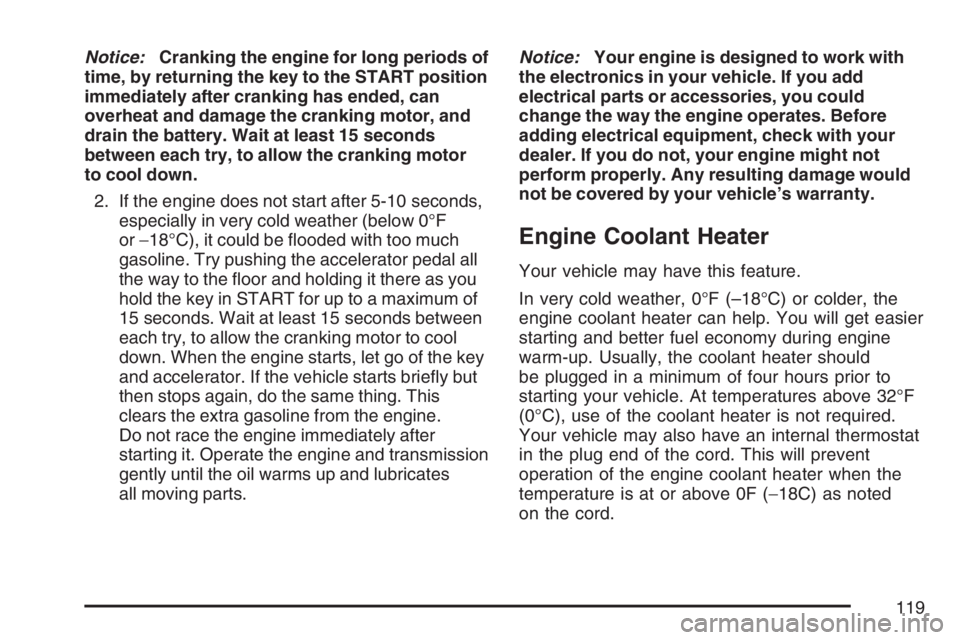
Notice:Cranking the engine for long periods of
time, by returning the key to the START position
immediately after cranking has ended, can
overheat and damage the cranking motor, and
drain the battery. Wait at least 15 seconds
between each try, to allow the cranking motor
to cool down.
2. If the engine does not start after 5-10 seconds,
especially in very cold weather (below 0°F
or−18°C), it could be �ooded with too much
gasoline. Try pushing the accelerator pedal all
the way to the �oor and holding it there as you
hold the key in START for up to a maximum of
15 seconds. Wait at least 15 seconds between
each try, to allow the cranking motor to cool
down. When the engine starts, let go of the key
and accelerator. If the vehicle starts brie�y but
then stops again, do the same thing. This
clears the extra gasoline from the engine.
Do not race the engine immediately after
starting it. Operate the engine and transmission
gently until the oil warms up and lubricates
all moving parts.Notice:Your engine is designed to work with
the electronics in your vehicle. If you add
electrical parts or accessories, you could
change the way the engine operates. Before
adding electrical equipment, check with your
dealer. If you do not, your engine might not
perform properly. Any resulting damage would
not be covered by your vehicle’s warranty.
Engine Coolant Heater
Your vehicle may have this feature.
In very cold weather, 0°F (–18°C) or colder, the
engine coolant heater can help. You will get easier
starting and better fuel economy during engine
warm-up. Usually, the coolant heater should
be plugged in a minimum of four hours prior to
starting your vehicle. At temperatures above 32°F
(0°C), use of the coolant heater is not required.
Your vehicle may also have an internal thermostat
in the plug end of the cord. This will prevent
operation of the engine coolant heater when the
temperature is at or above 0F (−18C) as noted
on the cord.
119
Page 120 of 492

To Use the Engine Coolant Heater
1. Turn off the engine.
2. Open the hood and unwrap the electrical
cord. The cord is located in the engine
compartment behind the underhood fuse block
on the driver’s side of the vehicle.
3. Plug it into a normal, grounded 110-volt AC
outlet.
{CAUTION:
Plugging the cord into an ungrounded
outlet could cause an electrical shock.
Also, the wrong kind of extension cord
could overheat and cause a �re. You
could be seriously injured. Plug the cord
into a properly grounded three-prong
110-volt AC outlet. If the cord will not
reach, use a heavy-duty three-prong
extension cord rated for at least 15 amps.
4. Before starting the engine, be sure to unplug
and store the cord as it was before to keep it
away from moving engine parts. If you do
not, it could be damaged.How long should you keep the coolant heater
plugged in? The answer depends on the outside
temperature, the kind of oil you have, and
some other things. Instead of trying to list
everything here, we ask that you contact your
dealer in the area where you will be parking your
vehicle. The dealer can give you the best
advice for that particular area.
Automatic Transmission Operation
Your automatic transmission has a shift lever on
the steering column.
It features an electronic shift position indicator
within the instrument cluster. This display must
be powered anytime the shift lever is capable of
being moved out of PARK (P). This means that if
your key is turned off, but not in LOCK, there will be
a small current drain on your battery which could
discharge your battery over a period of time.
120
Page 121 of 492

If you need to leave your key in the ignition but not
in LOCK for an extended period, it is recommended
that you disconnect the battery cable from the
battery to prevent discharging your battery.
There are several different positions for your
shift lever.
PARK (P):This position locks your rear wheels.
It is the best position to use when you start your
engine because your vehicle cannot move easily.
{CAUTION:
It is dangerous to get out of your vehicle
if the shift lever is not fully in PARK (P)
with the parking brake �rmly set. Your
vehicle can roll.
Do not leave your vehicle when the engine
is running unless you have to. If you have
left the engine running, the vehicle can
move suddenly. You or others could be
injured. To be sure your vehicle will not
CAUTION: (Continued)
CAUTION: (Continued)
move, even when you are on fairly level
ground, always set your parking brake
and move the shift lever to PARK (P).
SeeShifting Into Park (P) (Automatic
Transmission) on page 132. If you are
pulling a trailer, seeTowing a Trailer
on page 300.
Make sure the shift lever is fully in PARK (P)
before starting the engine. Your vehicle has an
automatic transmission shift lock control system.
You must fully apply your regular brakes before
you can shift from PARK (P) when the ignition key
is in ON. If you cannot shift out of PARK (P),
ease pressure on the shift lever by pushing the
shift lever all the way into PARK (P) as you
maintain brake application. Then move the shift
lever into another gear. SeeShifting Out of
Park (P) (Automatic Transmission) on page 134.
121
Page 130 of 492

7. Turn the engine off by turning the key
to ACC (Accessory).
8. Place the transmission shift lever in
PARK (P), or FIRST (1) for vehicles that
have a manual transmission.
9. Turn the ignition to LOCK.
Shifting Out of NEUTRAL
After towing your vehicle, you will have to shift out
of NEUTRAL in order to drive. To shift out of
NEUTRAL, do the following:
1. Set the parking brake and apply the regular
brake pedal.
2. Start a vehicle with an automatic transmission
in PARK (P). Use FIRST (1) for vehicles with
a manual transmission.
3. Shift the transmission to NEUTRAL (N), or
press the clutch pedal for vehicles with a
manual transmission.
4. Press the button for the desired transfer case
shift position (Two-Wheel High, Four-Wheel
High, or Four-Wheel Low).
5. After the transfer case has shifted out of
NEUTRAL, the indicator light will go out.
6. Release the parking brake.
7. Shift the transmission to the desired position.
Parking Brake
The parking brake pedal
is located to the left of
the regular brake pedal,
near the driver’s door.
To set the parking brake, hold the regular brake
pedal down with your right foot. Push the
parking brake pedal down to its fully-applied
position with your left foot.
A chime will activate and the brake warning light,
located on the instrument panel, will �ash when the
parking brake is applied and the vehicle is moving
at least 3 mph (5 km/h) for at least three seconds.
The chime will deactivate and the light will turn off
when the parking brake is set and the vehicle is
moving below 3 mph (5 km/h). SeeBrake System
Warning Light on page 185.
130
Page 132 of 492
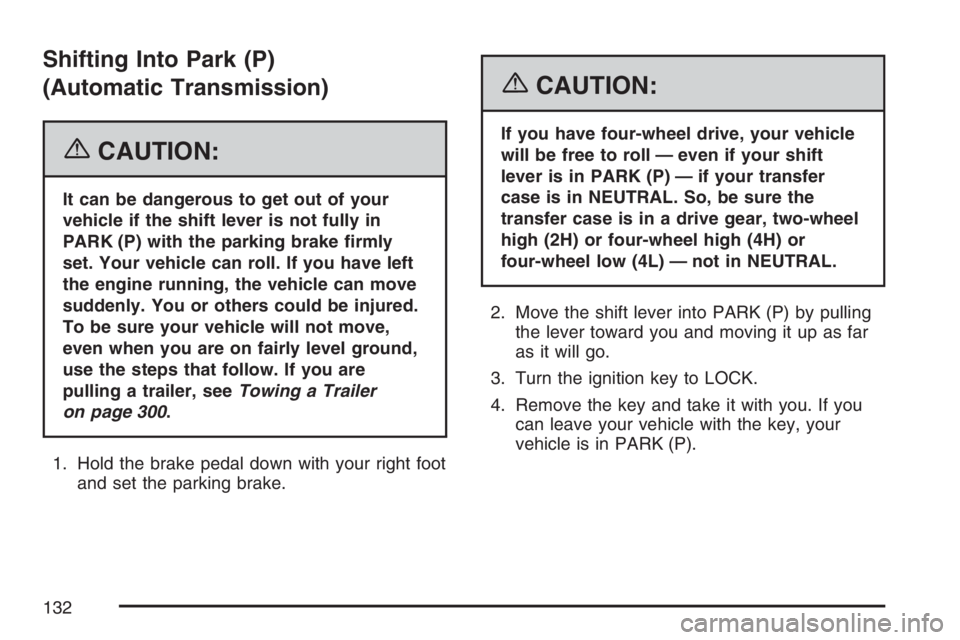
Shifting Into Park (P)
(Automatic Transmission)
{CAUTION:
It can be dangerous to get out of your
vehicle if the shift lever is not fully in
PARK (P) with the parking brake �rmly
set. Your vehicle can roll. If you have left
the engine running, the vehicle can move
suddenly. You or others could be injured.
To be sure your vehicle will not move,
even when you are on fairly level ground,
use the steps that follow. If you are
pulling a trailer, seeTowing a Trailer
on page 300.
1. Hold the brake pedal down with your right foot
and set the parking brake.
{CAUTION:
If you have four-wheel drive, your vehicle
will be free to roll — even if your shift
lever is in PARK (P) — if your transfer
case is in NEUTRAL. So, be sure the
transfer case is in a drive gear, two-wheel
high (2H) or four-wheel high (4H) or
four-wheel low (4L) — not in NEUTRAL.
2. Move the shift lever into PARK (P) by pulling
the lever toward you and moving it up as far
as it will go.
3. Turn the ignition key to LOCK.
4. Remove the key and take it with you. If you
can leave your vehicle with the key, your
vehicle is in PARK (P).
132
Page 134 of 492
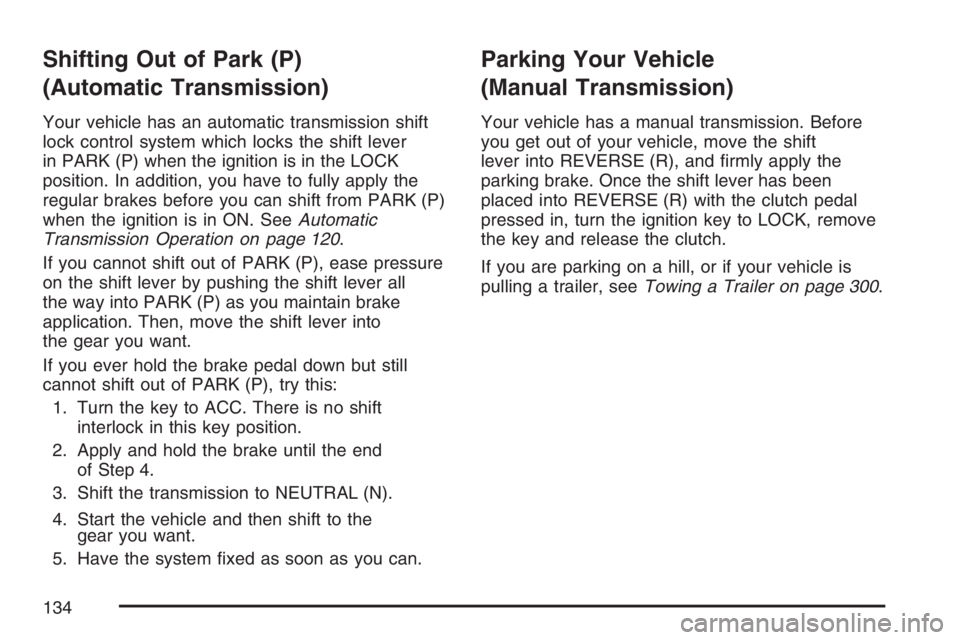
Shifting Out of Park (P)
(Automatic Transmission)
Your vehicle has an automatic transmission shift
lock control system which locks the shift lever
in PARK (P) when the ignition is in the LOCK
position. In addition, you have to fully apply the
regular brakes before you can shift from PARK (P)
when the ignition is in ON. SeeAutomatic
Transmission Operation on page 120.
If you cannot shift out of PARK (P), ease pressure
on the shift lever by pushing the shift lever all
the way into PARK (P) as you maintain brake
application. Then, move the shift lever into
the gear you want.
If you ever hold the brake pedal down but still
cannot shift out of PARK (P), try this:
1. Turn the key to ACC. There is no shift
interlock in this key position.
2. Apply and hold the brake until the end
of Step 4.
3. Shift the transmission to NEUTRAL (N).
4. Start the vehicle and then shift to the
gear you want.
5. Have the system �xed as soon as you can.
Parking Your Vehicle
(Manual Transmission)
Your vehicle has a manual transmission. Before
you get out of your vehicle, move the shift
lever into REVERSE (R), and �rmly apply the
parking brake. Once the shift lever has been
placed into REVERSE (R) with the clutch pedal
pressed in, turn the ignition key to LOCK, remove
the key and release the clutch.
If you are parking on a hill, or if your vehicle is
pulling a trailer, seeTowing a Trailer on page 300.
134
Page 146 of 492
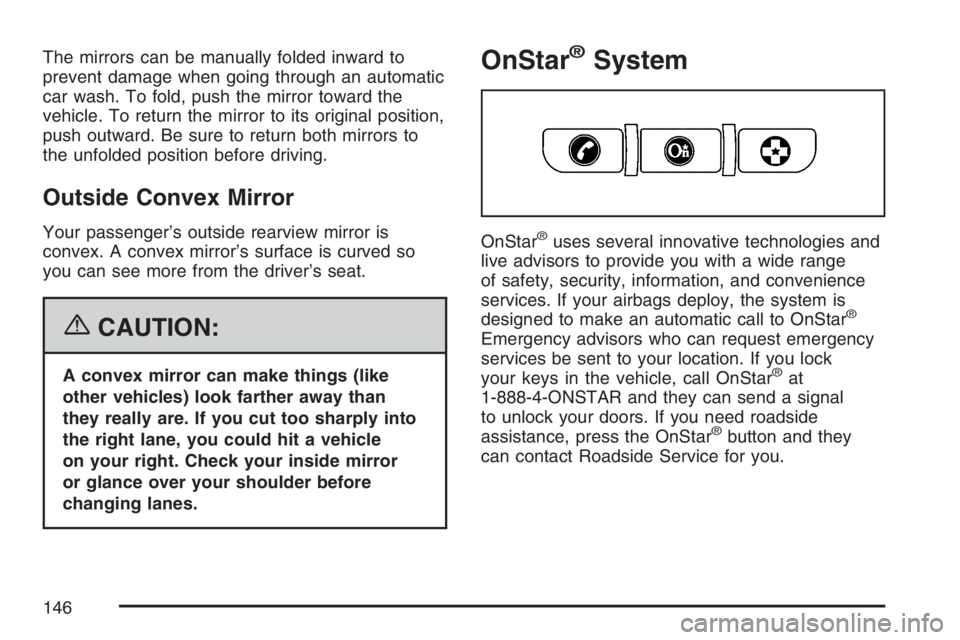
The mirrors can be manually folded inward to
prevent damage when going through an automatic
car wash. To fold, push the mirror toward the
vehicle. To return the mirror to its original position,
push outward. Be sure to return both mirrors to
the unfolded position before driving.
Outside Convex Mirror
Your passenger’s outside rearview mirror is
convex. A convex mirror’s surface is curved so
you can see more from the driver’s seat.
{CAUTION:
A convex mirror can make things (like
other vehicles) look farther away than
they really are. If you cut too sharply into
the right lane, you could hit a vehicle
on your right. Check your inside mirror
or glance over your shoulder before
changing lanes.
OnStar®System
OnStar®uses several innovative technologies and
live advisors to provide you with a wide range
of safety, security, information, and convenience
services. If your airbags deploy, the system is
designed to make an automatic call to OnStar
®
Emergency advisors who can request emergency
services be sent to your location. If you lock
your keys in the vehicle, call OnStar
®at
1-888-4-ONSTAR and they can send a signal
to unlock your doors. If you need roadside
assistance, press the OnStar
®button and they
can contact Roadside Service for you.
146
Page 158 of 492

Hazard Warning Flashers
The hazard warning �ashers let you warn the
police and others that you have a problem.
The front and rear turn signal lamps will �ash
on and off.
The hazard warning
�asher button is located
on the instrument
panel, between the
two air vents in
the center.
The hazard warning �ashers work no matter what
position the key is in, and even if the key is not
in the ignition.
Press the button to make the front and rear turn
signal lamps �ash on and off. Press the button
again to turn the �ashers off.
When the hazard warning �ashers are on, the turn
signals will not work.
Other Warning Devices
If you carry re�ective triangles, you can set one up
at the side of the road about 300 feet (100 m)
behind your vehicle.
Horn
To sound the horn, press the horn symbol on the
steering wheel pad.
Tilt Wheel
A tilt wheel allows you to adjust the steering wheel
before you drive. The tilt steering wheel can be
raised to the highest level to allow more room for
the driver to enter and exit the vehicle.
158
Page 167 of 492
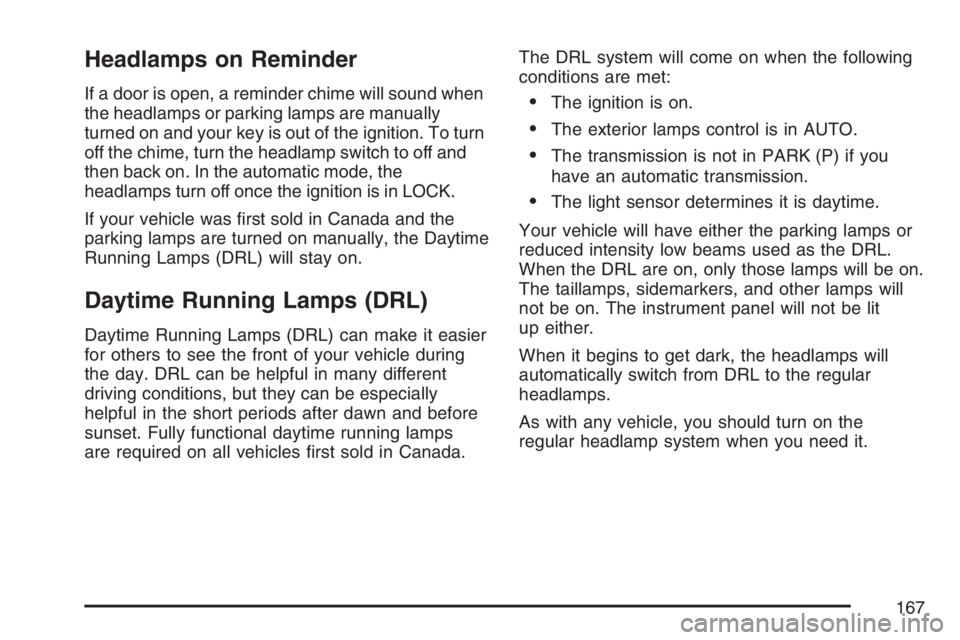
Headlamps on Reminder
If a door is open, a reminder chime will sound when
the headlamps or parking lamps are manually
turned on and your key is out of the ignition. To turn
off the chime, turn the headlamp switch to off and
then back on. In the automatic mode, the
headlamps turn off once the ignition is in LOCK.
If your vehicle was �rst sold in Canada and the
parking lamps are turned on manually, the Daytime
Running Lamps (DRL) will stay on.
Daytime Running Lamps (DRL)
Daytime Running Lamps (DRL) can make it easier
for others to see the front of your vehicle during
the day. DRL can be helpful in many different
driving conditions, but they can be especially
helpful in the short periods after dawn and before
sunset. Fully functional daytime running lamps
are required on all vehicles �rst sold in Canada.The DRL system will come on when the following
conditions are met:
The ignition is on.
The exterior lamps control is in AUTO.
The transmission is not in PARK (P) if you
have an automatic transmission.
The light sensor determines it is daytime.
Your vehicle will have either the parking lamps or
reduced intensity low beams used as the DRL.
When the DRL are on, only those lamps will be on.
The taillamps, sidemarkers, and other lamps will
not be on. The instrument panel will not be lit
up either.
When it begins to get dark, the headlamps will
automatically switch from DRL to the regular
headlamps.
As with any vehicle, you should turn on the
regular headlamp system when you need it.
167
Page 171 of 492
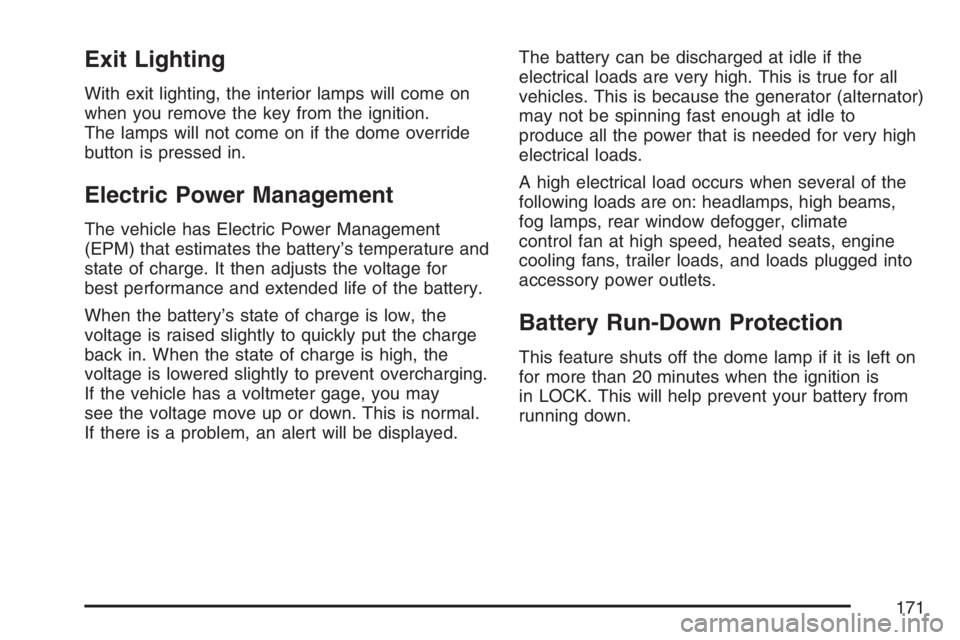
Exit Lighting
With exit lighting, the interior lamps will come on
when you remove the key from the ignition.
The lamps will not come on if the dome override
button is pressed in.
Electric Power Management
The vehicle has Electric Power Management
(EPM) that estimates the battery’s temperature and
state of charge. It then adjusts the voltage for
best performance and extended life of the battery.
When the battery’s state of charge is low, the
voltage is raised slightly to quickly put the charge
back in. When the state of charge is high, the
voltage is lowered slightly to prevent overcharging.
If the vehicle has a voltmeter gage, you may
see the voltage move up or down. This is normal.
If there is a problem, an alert will be displayed.The battery can be discharged at idle if the
electrical loads are very high. This is true for all
vehicles. This is because the generator (alternator)
may not be spinning fast enough at idle to
produce all the power that is needed for very high
electrical loads.
A high electrical load occurs when several of the
following loads are on: headlamps, high beams,
fog lamps, rear window defogger, climate
control fan at high speed, heated seats, engine
cooling fans, trailer loads, and loads plugged into
accessory power outlets.
Battery Run-Down Protection
This feature shuts off the dome lamp if it is left on
for more than 20 minutes when the ignition is
in LOCK. This will help prevent your battery from
running down.
171